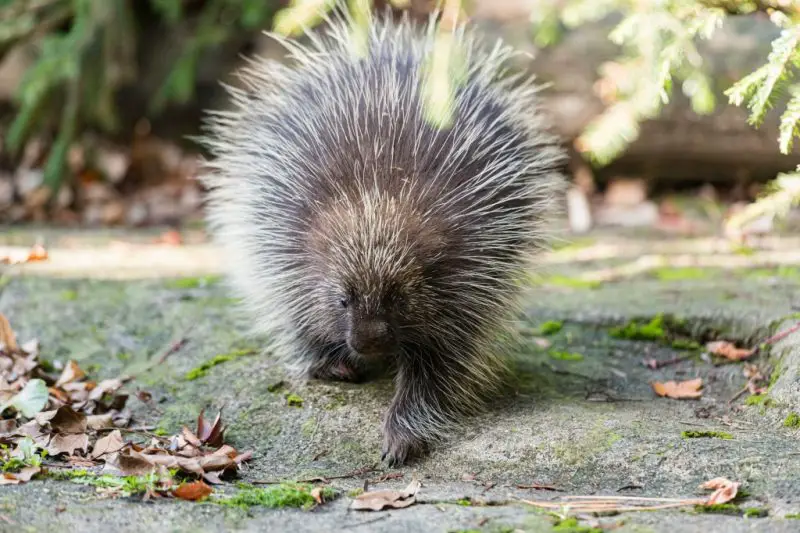Porcupines in Michigan are fascinating creatures that often spark curiosity among wildlife enthusiasts. Known for their spiny quills and slow, deliberate movements, these animals are a vital part of Michigan’s woodland ecosystems. Although they are not as frequently spotted as deer or squirrels, porcupines play an important ecological role by feeding on vegetation and contributing to forest health.
Understanding how to identify a porcupine, learning about its daily habits, and uncovering some unique facts can make your encounters with these animals even more memorable. This guide provides in-depth information about porcupines in Michigan, their appearance, behaviors, diet, and where you are most likely to see them in the wild.
Identification of Porcupines in Michigan

Physical Characteristics
The only porcupine species native to Michigan is the North American Porcupine (Erethizon dorsatum). It is the second-largest rodent in North America, after the beaver, and can weigh between 12 and 35 pounds. Adult porcupines measure around 25 to 36 inches in length, with an additional 8 to 10 inches for their short, bushy tail. Their body is stocky and covered with a combination of brownish-black fur and thousands of sharp quills that serve as their primary defense mechanism.
Porcupine quills are hollow, lightweight, and tipped with microscopic barbs that easily lodge into an attacker’s skin. Contrary to popular myths, porcupines cannot shoot their quills; instead, the quills detach when a predator makes contact. A single porcupine may have up to 30,000 quills, making it well-protected against most predators.
Their small round face, blunt nose, and large front teeth give them a distinctive appearance. Sharp orange incisors, adapted for gnawing, are one of their most noticeable features when feeding on bark or branches. Their feet are equipped with long claws that are ideal for climbing, a skill that helps them access food sources high in the trees.
How to Identify Them in the Wild
Spotting a porcupine in Michigan is often easier in forested areas where evidence of their feeding is visible. Look for bark stripped from trees, especially on hemlock, pine, or aspen. Another sign is distinctive tracks in snow or mud, which show five toes on the back feet and four on the front, often with tail drag marks. Because porcupines are mostly nocturnal, they are best observed at dawn, dusk, or during the night when they leave their dens to forage.
In winter, you may also find porcupines sitting in conifer trees, feeding on needles and twigs. Their slow movements and dark coloration often make them blend with the tree bark, but their rounded shape and quills are giveaways if you look closely.
Habits and Behavior of Michigan Porcupines
Daily Activity Patterns
Porcupines in Michigan are primarily nocturnal, spending most of the day sleeping in tree cavities, hollow logs, or sheltered rocky crevices. They become active after sunset, moving slowly but purposefully in search of food. Despite their clumsy appearance, porcupines are excellent climbers and spend a significant amount of time in trees, particularly during winter when ground-level vegetation is scarce.
During warmer months, porcupines often move along well-established feeding trails. These trails are sometimes marked by trampled grass or quill shed, making them easier for trackers to follow. Though they are generally solitary, porcupines may occasionally share dens in the winter for warmth, especially in colder regions of Michigan’s Upper Peninsula.
Feeding Habits
Porcupines are herbivorous and have a diet that changes with the seasons. In spring and summer, they feed on green vegetation, including leaves, berries, and herbs. They also consume tender shoots and new growth on trees. As autumn approaches, they shift to eating bark, twigs, and evergreen needles, relying heavily on trees like hemlock, pine, and aspen for survival during the cold months.
Their strong incisors allow them to gnaw through tough bark and woody stems. In winter, porcupines are often seen clinging to tree trunks, stripping bark to access the nutrient-rich cambium layer. This feeding behavior can sometimes damage trees, making porcupines less popular with foresters. However, this habit also helps thin older branches, encouraging new growth in the forest ecosystem.
Defense and Communication
Porcupines rely heavily on their quills for defense. When threatened, they turn their back toward the predator, raise their quills, and lash with their tail if the attacker comes too close. The barbed quills detach easily and embed deeply into the predator’s skin, making most animals think twice before attacking again.
They are generally quiet animals but may produce vocalizations such as grunts, whines, or high-pitched cries, especially during mating season or when feeling threatened. Porcupines also use scent markings from glands near their tail to communicate territory boundaries and readiness to mate.
Reproduction and Life Cycle
Porcupine mating season in Michigan typically occurs in late fall. Males compete for females by vocalizing and even engaging in minor physical confrontations, although serious injuries are rare. After mating, the female undergoes a long gestation period of about seven months, giving birth to a single baby, known as a porcupette, in spring or early summer.
Porcupettes are born with soft quills that harden within hours, giving them immediate protection. Young porcupines stay with their mother for several months, learning to climb and forage before becoming independent. In the wild, porcupines can live up to 6 to 8 years, although some individuals have been known to survive longer.
Habitat and Distribution in Michigan
Where Porcupines Live
Porcupines are widespread across Michigan, but they are more abundant in the Upper Peninsula and northern parts of the Lower Peninsula, where dense forests provide ideal habitats. Mixed conifer and deciduous forests are their preferred environment, offering both food and shelter. They are also found in areas with rocky outcrops, wetlands, and abandoned farmlands that have reverted to woodlands.
In the southern regions of Michigan, porcupines are less common due to habitat fragmentation and human development. However, sightings are not unheard of, especially in larger forested parks and nature reserves.
Seasonal Movements
Porcupines do not migrate long distances but may change their feeding locations seasonally. In winter, they remain closer to evergreen forests, relying on coniferous trees for food. In warmer months, they wander further in search of fresh vegetation, sometimes coming closer to rural properties where ornamental trees and gardens provide an easy meal.
Fun Facts About Porcupines in Michigan
Unique Adaptations
Porcupines have several fascinating adaptations that make them unique among Michigan’s wildlife. Their quills are not only a defense mechanism but also provide insulation against harsh winters. The hollow structure of the quills traps air, helping conserve body heat in cold conditions.
Despite being slow and awkward on the ground, porcupines are exceptional climbers. Their strong claws and rough footpads allow them to grip tree bark securely, even when feeding high in the canopy.
Interaction With Other Wildlife
Because of their quills, porcupines have few natural predators. However, some animals, such as fishers and wolverines, have developed unique strategies to flip porcupines onto their backs, where the belly is unprotected. In Michigan, fishers have made a comeback in certain regions, which may slightly impact porcupine populations.
Interestingly, porcupines sometimes chew on shed antlers and animal bones, not for meat but for the calcium and minerals they contain. This behavior helps keep their ever-growing teeth in check.
Porcupines and Humans
Although porcupines are generally harmless to humans, they can cause problems by chewing on wooden structures, tool handles, or even vehicle tires. This behavior is often due to their attraction to salt residues left by road treatments or human sweat. In forested regions of Michigan, they may also damage valuable timber by stripping bark.
Despite these issues, porcupines play an essential ecological role by promoting forest regeneration. Their selective feeding encourages new plant growth, and abandoned porcupine dens provide shelter for other wildlife, including small mammals and birds.
FAQs About Porcupines in Michigan
Are porcupines common in Michigan?
Yes, porcupines are common in Michigan, particularly in the Upper Peninsula and northern Lower Peninsula, where dense forests and rocky habitats are abundant.
Are porcupines dangerous to humans?
Porcupines are not aggressive and will not attack humans. They only use their quills in self-defense when threatened. Avoid approaching or handling them to prevent accidental injury.
Can you see porcupines during the day?
Porcupines are mostly nocturnal but can occasionally be seen feeding or sunning themselves during the day, especially in winter when food sources are limited.
What do porcupines eat in Michigan?
They feed on leaves, twigs, and berries during warmer months, shifting to bark, needles, and buds of trees like hemlock, aspen, and pine during winter.
Where is the best place to see porcupines in Michigan?
The best chance of spotting porcupines is in the forests of the Upper Peninsula, especially near coniferous and mixed woodlands. State parks and wildlife reserves also provide good viewing opportunities.
Conclusion
Porcupines in Michigan are remarkable animals that contribute to the state’s diverse wildlife population. Their unique quills, slow but deliberate movements, and fascinating behaviors make them a species worth observing and appreciating. By understanding their habits, diet, and preferred habitats, you can increase your chances of spotting these intriguing creatures in the wild. In the snowy forests of the Upper Peninsula or the wooded areas of the Lower Peninsula, a quiet evening walk may reward you with the sight of one of Michigan’s most iconic rodents.






